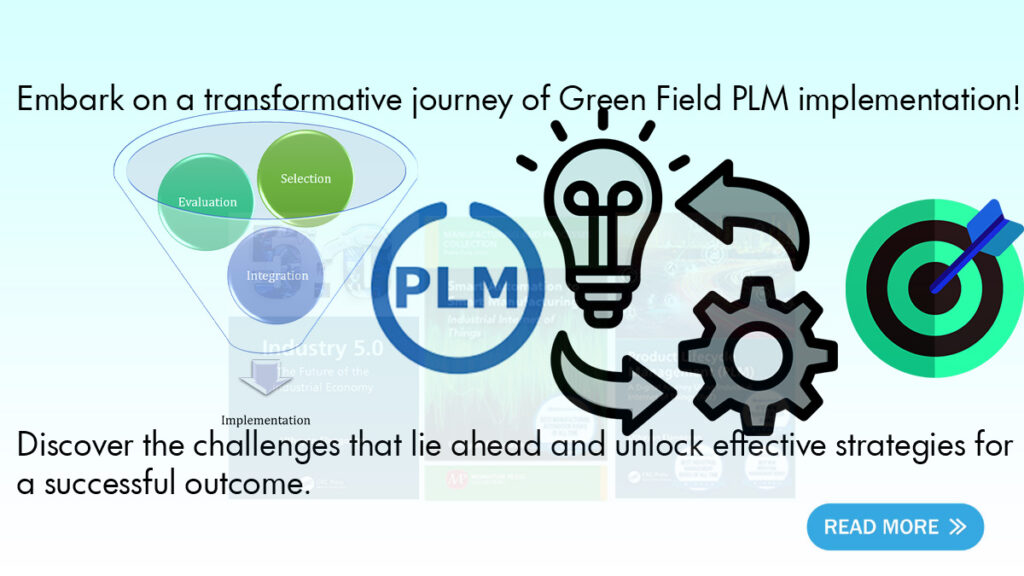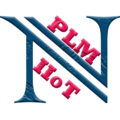Explore Green Field PLM implementation in manufacturing, including challenges and effective strategies for success. Stay ahead in the competitive market by mastering PLM implementation in your manufacturing endeavors!

Introduction:
Product Lifecycle Management (PLM) has become an indispensable tool for businesses seeking enhanced efficiency, reduced time-to-market, and improved collaboration throughout the product development cycle. Green field PLM implementation, which involves starting from scratch without any existing PLM infrastructure, presents unique challenges and opportunities for manufacturing industries. In this blog post, we will delve into the major hurdles faced during PLM green field implementation, explore the roll-out of PLM functions, and provide actionable steps to mitigate potential roadblocks.
Challenges in PLM Green Field Implementation:
1.Understanding Business Objectives: One of the initial hurdles in green field PLM implementation is defining clear and achievable business objectives. Without a well-defined roadmap, the project risks becoming disjointed, leading to inefficiencies and missed opportunities.
2.Data Management and Integration: Implementing PLM in a manufacturing environment involves integrating data from various sources and legacy systems. Incompatible data formats, outdated systems, and data silos can hinder the smooth flow of information and collaboration across departments.
3.Organizational Change Management: Adopting PLM brings about a significant cultural shift within an organization. Resistance to change, lack of buy-in from employees, and insufficient training can undermine the successful implementation of PLM functions.
4.Vendor and Solution Selection: Choosing the right PLM vendor and solution is critical to the success of green field implementation. An ill-fitted system may not align with the company’s needs and might lead to costly customization efforts or a suboptimal implementation.
5.Complexity and Scalability: Manufacturers often deal with intricate product structures and extensive supply chains. Ensuring that the PLM system can handle this complexity and can scale as the business grows is a considerable challenge.
Mitigation Strategies for Successful PLM Implementation:
- Thorough Planning and Road mapping: Start with a comprehensive assessment of your business objectives, processes, and challenges. Develop a detailed roadmap that outlines the steps, timelines, and resources required for PLM implementation.
- Data Migration and Integration Strategy: Prioritize data management and integration planning early in the process. Cleanse and consolidate existing data, establish data governance protocols, and select tools that facilitate seamless data transfer between systems.
- Change Management and Training: Involve key stakeholders from the beginning and communicate the benefits of PLM adoption. Provide extensive training to employees to help them embrace the new system effectively.
- Partner with an Experienced PLM Consultant: Collaborate with a reputable PLM consulting service like Neel SMARTEC, equipped with a proven track record of successful PLM implementations. Their expertise can streamline the selection process and ensure a tailored solution that aligns with your business needs.
- Customization with Caution: While some level of customization may be necessary, avoid over-customization as it can lead to increased complexity and higher maintenance costs. Focus on adapting your processes to best practices supported by the PLM system.
- Continuous Evaluation and Improvement: Implementing PLM is not a one-time event. Continuously evaluate the system’s performance and gather feedback from users to identify areas for improvement and optimization.
Having gathered insights from C-Level Executives regarding the costing challenges of PLM implementation, let’s now explore the essential factors that need to be taken into consideration.
Costing Challenges:
- Total Cost of Ownership (TCO) Concerns: Implementing PLM involves upfront costs, ongoing maintenance, and licensing fees, which collectively contribute to the Total Cost of Ownership (TCO). Unforeseen expenses and inaccurate TCO projections can strain budgets and lead to financial challenges.
- Return on Investment (ROI) Uncertainty: Determining the Return on Investment (ROI) for a PLM implementation can be challenging, especially in the early stages. Organizations may struggle to measure tangible benefits, making it difficult to gauge the project’s success and justify the investment.
- Return on Value (ROV) Assessment: Return on Value (ROV) focuses on assessing the overall value and benefits gained from the PLM implementation beyond financial metrics. Measuring non-financial benefits like improved collaboration, reduced time-to-market, and enhanced product quality can be complex.
Mitigation Strategies for TCO, ROI, and ROV Challenges:
- Comprehensive Cost Analysis: Before embarking on PLM implementation, conduct a thorough cost analysis that includes not only the initial expenses but also ongoing maintenance and support costs. Working with experienced PLM consultants like Neel SMARTEC can help in accurate cost estimation.
- Phased Implementation Approach: Opt for a phased implementation approach that allows you to measure ROI incrementally. Start with a pilot project or implement PLM in a specific department, and then expand gradually based on the success observed in each phase.
- Establish Measurable Objectives: Clearly define and quantify the objectives of the PLM implementation. Set measurable key performance indicators (KPIs) that align with business goals and track them throughout the project’s lifecycle.
- Benchmarking and Best Practices: Conduct benchmarking with industry peers to gain insights into the potential benefits and challenges of PLM adoption. Embrace industry best practices and align them with your business processes to maximize ROI and ROV.
- Engage Key Stakeholders: Involve key stakeholders from various departments in the planning and decision-making process. Their involvement ensures a more accurate assessment of potential ROI and ROV and helps gain broader buy-in for the project.
- Continuous Monitoring and Evaluation: Implement a robust monitoring and evaluation system to track the actual benefits achieved after PLM roll-out. Regularly review progress against the predefined KPIs and make necessary adjustments to optimize the value obtained.
- Leverage PLM Vendor Expertise: Work closely with the chosen PLM vendor, leveraging their expertise in measuring ROI and ROV. Vendors with experience in the manufacturing industry can provide valuable insights and best practices to enhance overall value.
Conclusion:
PLM green field implementation in the manufacturing industry offers immense potential for streamlining processes, enhancing collaboration, and driving innovation. Nevertheless, the path forward is not without its obstacles. While PLM green field implementation poses several challenges related to TCO, ROI, and ROV, organizations can overcome these obstacles with strategic planning, meticulous analysis, and a focus on continuous improvement. By recognizing the hurdles and adopting well-thought-out strategies, organizations can overcome obstacles and ensure a successful PLM roll-out.
Are you ready to take your manufacturing business to new heights with a robust PLM implementation? Connect with Neel SMARTEC, the industry-leading PLM business consulting services, for a smooth and cost-effective journey. Our experienced team is committed to tailoring the perfect PLM solution for your unique needs. Contact us to schedule a consultation today and unlock the true potential of your product development process. Let’s embark on this transformative PLM journey together!


